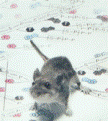Papers in the Biological Sciences

Jay F. Storz Publications
Document Type
Article
Date of this Version
4-2013
Citation
The Journal of Experimental Biology 216, 1167-1173; doi:10.1242/jeb.079848
Abstract
In vertebrates living at high altitude, arterial hypoxemia may be ameliorated by reversible changes in the oxygen-carrying capacity of the blood (regulated by erythropoiesis) and/or changes in blood–oxygen affinity (regulated by allosteric effectors of hemoglobin function). These hematological traits often differ between taxa that are native to different elevational zones, but it is often unknown whether the observed physiological differences reflect fixed, genetically based differences or environmentally induced acclimatization responses (phenotypic plasticity). Here, we report measurements of hematological traits related to blood–O2 transport in populations of deer mice (Peromyscus maniculatus) that are native to high- and low-altitude environments. We conducted a common-garden breeding experiment to assess whether altitude-related physiological differences were attributable to developmental plasticity and/or physiological plasticity during adulthood. Under conditions prevailing in their native habitats, high-altitude deer mice from the Rocky Mountains exhibited a number of pronounced hematological differences relative to low-altitude conspecifics from the Great Plains: higher hemoglobin concentrations, higher hematocrits, higher erythrocytic concentrations of 2,3-diphosphoglycerate (an allosteric regulator of hemoglobin–oxygen affinity), lower mean corpuscular hemoglobin concentrations and smaller red blood cells. However, these differences disappeared after 6weeks of acclimation to normoxia at low altitude. The measured traits were also indistinguishable between the F1 progeny of highland and lowland mice, indicating that there were no persistent differences in phenotype that could be attributed to developmental plasticity. These results indicate that the naturally occurring hematological differences between highland and lowland mice are environmentally induced and are largely attributable to physiological plasticity during adulthood.
Includes Supplementary material.
Issue cover


Comments
© 2013. Published by The Company of Biologists Ltd. Used by permission.